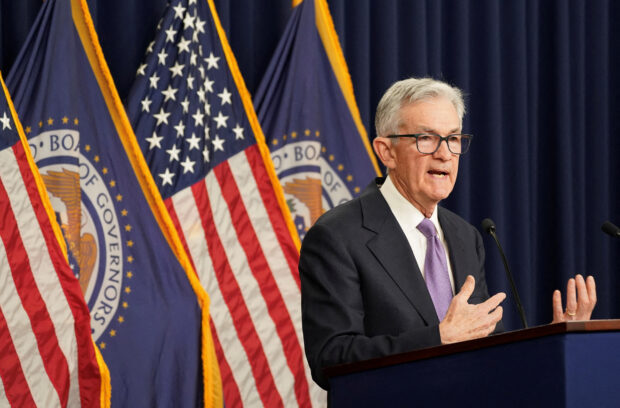Fed minutes cite lower inflation risks, ‘overly restrictive’ policy

FILE PHOTO: Federal Reserve Board Chairman Jerome Powell speaks during a press conference following a closed two-day meeting of the Federal Open Market Committee on interest rate policy at the Federal Reserve in Washington, U.S., December 13, 2023. REUTERS/Kevin Lamarque/File Photo
WASHINGTON –Federal Reserve officials in December launched an expansive debate about a coming turn in U.S. monetary policy, with fresh concerns voiced about how long the economy could hold up under current high interest rates and at least initial discussion about when to halt the rundown of its balance sheet, according to minutes of the Dec. 12-13 meeting.
Fed Chair Jerome Powell had laid out the broad contours of the meeting at a press conference held at its conclusion, noting that the central bank was likely done raising interest rates and expected to begin reducing borrowing costs by the end of 2024.
While the minutes did not provide direct clues about when rate cuts might commence, they reflected a growing sense that inflation is under control and growing concern about the risks that “overly restrictive” monetary policy may pose to the economy.
The document caps a year that began with the Fed still uncertain about how much harm it might have to inflict on the economy to control inflation and Powell warning of “pain” to come, but ended with inflation falling faster than anticipated and policymakers becoming increasingly hopeful that they could tame inflation while skirting the recession even staff members thought was sure to come.
Initial debate about when to stop the rundown in the Fed‘s asset holdings showed policymakers edging towards reversal of a separate policy that, with less impact but in similar fashion to rate hikes, has also been restricting economic activity as part of the Fed‘s battle against the worst breakout of inflation in 40 years.
READ: Fed’s preferred inflation gauge shows price pressures continuing to cool
“Participants pointed to the decline in inflation seen during 2023, noting the recent shift down in six-month inflation readings in particular,” the minutes said.
Diminishing inflation risks
The core personal consumption expenditures price index on a six-month basis through November has run just below the Fed‘s 2-percent target. For the first time since June 2022 policymakers did not use the phrase “unacceptably high” to describe inflation, according to the minutes, while laying out reasons why they felt inflation would continue to fall.
There were still risks, with several participants saying they felt the Fed had gotten all the help it could expect from improved supply chains to lower inflation, with tight monetary policy still needed to dampen demand and new geopolitical risks possibly causing inflation progress to stall.
But participants also considered the overall risk of renewed inflation “as having diminished,” while “a few” Fed officials saw a different problem developing: That the Fed would soon confront a “tradeoff” between its dual goals of controlling inflation and maintaining high rates of employment, a sacrifice Powell has pledged to try to avoid.
READ: US job openings fell slightly in November
That specific concern has been conspicuously absent from Fed debates in recent months, with inflation falling while the unemployment rate, at 3.7 percent, remains at a level many economists consider near or even below full employment.
The fact that it has now surfaced suggests a growing sense that the economy could still hit a breaking point despite the growing hope among some Fed officials that a “soft landing” from high inflation is close.
“Several participants noted the risk that, if labor demand were to weaken substantially further, the labor market could transition quickly from a gradual easing to a more abrupt downshift in conditions,” the minutes noted.
New jobs data for December will be issued Friday.
According to projections issued at the Fed‘s December meeting, all but two Fed officials see the benchmark policy rate lower by the end of 2024 than it is now, with a majority of policymakers seeing it trimmed by at least three quarters of a percentage point. The target rate has been held in a range of from 5.25 percent to 5.5 percent since July.
U.S. stocks slightly pared losses following the release of the minutes but were still down for a second straight day, while the U.S. dollar added to gains against a basket of currencies. U.S. Treasury yields were little changed.
Traders of interest rate futures largely stuck to bets that the central bank’s Federal Open Market Committee would start to cut rates in March, with the policy rate seen ending the year in the 3.75 percent-4 percent range, 1.5 percentage points lower than where it is now.
“There is nothing in these minutes to dissuade us that the Fed will start to cut interest rates from this March onwards,” said Paul Ashworth, Chief North America economist at Capital Economics.
No start signal yet
The minutes in fact shed little direct light on when rate cuts might commence. Participants noted “an unusually elevated degree of uncertainty” about the economic outlook, with further rate increases still possible.
READ: With rate hikes likely done, Fed turns to timing of cuts
But “most” felt that monetary policy was having its intended impact on inflation and would continue to do so by dampening household and business spending and pulling inflation back to target.
Coming policy decisions would be “careful and data-dependent,” the minutes said.
The Fed next meets on Jan. 30-31.